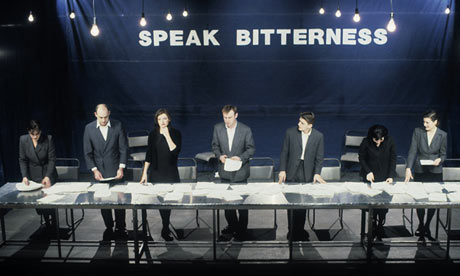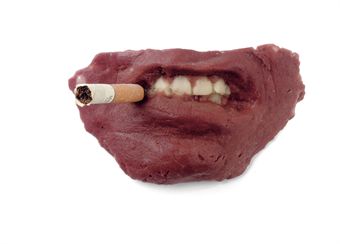
"For us Performance and Confession have always gone hand in hand..." (Tim Etchells). Analyse the ways in which confession is made to perform through the use of many art forms, making particular reference to Forced Entertainment's Speak Bitterness. Use your knowledge of Forced Entertainment's 'Total Theatre' as well as the 'language of theatre' to support your answer.
The idea of performance and confession as being fundamentally linked, one dependent on the other, raises questions as to the nature of both performance and confession. Can the most basic act of performance, that of exposing the body and the voice to an audience be seen as a confession, perhaps provoking judgement, comparison or pity? The theatrical space is an intensified reality, every word, gesture or movement has a heightened significance, for example; the simple act of a performer lowering their eyes or head could be interpreted by an audience as a confession of weakness or defeat.
It is the apparently random, fragmented and semi-improvised performance of Forced Entertainment's Speak Bitterness that confesses the human condition of the late twentieth and early twenty first centuries. A kind of postmodern mindset is emerging where the only absolute truths are negatives, namely; death, weakness and failure. It is this lack of positive truths that Speak Bitterness deals with when attempting to invoke feelings of fear and pity in the audience; fear of the terrifying picture of society that is being constructed through some of the confessions, as well as identification and concurrence with those confessions; pity for the degradation of society that has resulted in the actions being confessed to, as well as feelings of powerlessness, frustration and despair
Any act of confession relies on establishing an intimate relationship with an audience, otherwise anything that happens in the theatre space will be as effective and as potent as screaming in a vacuum. Speak Bitterness bears this in mind as each of its confessions follows the basic formula "we did this". The "we" has the power of ambiguity to either encompass every person in the theatre space, or just the performers. The former makes each confession both universal, as a shared statement, and sometimes intensely personal. The confessions are drawn from a multitude of cross cultural experiences, from those of the performers themselves, to ones imagined, to those of journalists and soldiers who have witnessed and carried out unspeakable horrors in
The use of the theatrical space is also a vital tool for establishing a relationship with the audience. In Speak Bitterness, the stage and audience are distinctly separate, which seems to suggest a confrontational approach to the sharing of confessions. However, as well as this separation, there is a wholeness of space brought about by the use of several hanging light bulbs, ensuring that the audience is lit throughout. Such lighting, combined with the bleak, almost monochrome setting of both performers and backdrop, a blue hung tarpaulin with the text "SPEAK BITTERNESS" printed on it in white, creates a temporary, transitory feel. It also creates a feeling of poverty, both relating to the company themselves perhaps, but also the impoverished state of morality from which a lot of the confessions are borne. The soundscape works with the setting in contributing to this impoverished and awkward feeling, an ethereal, ambient recorded soundtrack combined with the footsteps and voices of the actors. Speak Bitterness is, in terms of audience address through space, a mixture of Artaudian and Brechtian theory on how the space should be used. Artaud wanted the audience to be a part of the theatrical experience, immersed in it: "A direct communication will be re-established between spectator and the spectacle, between the actor and spectator.". Speak Bitterness' audience involvement works, perhaps ironically, mostly through the text, Brecht on the other hand wanted the audience to remain outside the action, in order to view it objectively. Another Brechtian influence in Speak Bitterness is the method of directly addressing the audience, this has the interesting effect of both establishing a boundary, as in "we are the performers, you are the audience" but simultaneously destroying that boundary by allowing the audience to connect with the performers through eye contact.
The fragmented, disconnected nature of the script of confessions does two things in terms of linear storytelling. It destroys any sense of narrative, except perhaps in the most basic sense that a performer begins confessing and sooner or later that list will be exhausted, although one could argue that given the unstructured approach to performance, an almost infinite number of combinations and arrangements could be possible, resulting in an open ended performance. The nature of the 'script' also denies the formation of characters in the dramatic sense. However in one performance, a combination of confessions features the isolation of one performer, down stage, whilst other performers are up stage, a kind of micro-narrative emerges, where the embryo of a character is beginning to be formed. Through the confessions spoken by the up stage performers, which are repeated by the downstage performer, a kind of character history is being created. This idea is reinforced by the performers’ facial expression and posture which convey a sense of reminiscing, of looking back on the past. Hesitation and facial expression are used to signify a reluctance to reveal aspects of the characters past, due to embarrassment, shame and fear of judgement. Such performance details invite judgement from the audience whilst maintaining the shared nature of the confessions. An audience’s perception of what being confessed to does depend on who is doing the confessing, for example: “We’re guilty of homemade bombs and homemade wine. We’re guilty of coldness and spite. We never laughed and we never found the time....” potentially carries different meanings depending on whether it was spoken by a man or a woman. Due to the informal approach to performance, and the non-gender specific confessions, either a female or a male could read them. The setting invites comparison with the conventions of news broadcasting or the press conference, with the long table running left to right down stage and the chairs positioned behind it. This arrangement again highlights the contrasting methods of audience address in this performance. The austerity of the costume, almost entirely black and white, also creates a sense of mourning, as well as reinforcing the idea of a news broadcast, perhaps mourning of morality and of joie-de-vivre.

Confession in the public arena, as seen in higher art forms such as visual art and theatre, as well as lower art forms such as popular music, television and film, works mainly on two levels. Firstly, it addresses the need for absolution, catharsis or simply expression of the artists self. Secondly, it serves to place an idea in the public consciousness about what is acceptable behaviour and to provoke discussion about how people should live their lives. The artist Sarah Lucas' highly personal, confrontational art could be seen as her confession of humanity, of her weaknesses and of her strengths. Her 1994 piece "Where Does It All End?", a blood-red wax moulding of a sneering lower half of a face, with a cigarette held between clenched teeth could be seen as a confession of mortality, a knowingness of the inevitability of death, exaggerated by the cigarette. But at odds with this is a confession of defiance in the face of this fact, shown by the sneering expression and clenched teeth. In addition to this, the cigarette could also signify a confession of ambivalence to the world and even to herself.
In popular music, confession is most often made to speak in terms of relationships, as a confession of love or of a loss of love. However there are exceptions, the album The Holy Bible by Manic Street Preachers is an example of confession serving both the needs of the creator for expression and also for placing, or in this case forcing ideas onto the audience's consciousness. Its confessions range from the personal; "I am idiot drug hive, the virgin, the tattered and the torn" to the global and historical; "
Confessions of these kinds could be seen as self indulgence, serving the needs of the artist whilst the audience is emotionally affected by the confessions, yet ultimately powerless to do anything about them. This is perhaps why theatre or film are more effective and constructive media for the transmission of confessions. They are both, mostly, durational pieces of work where the audience has a chance to interact emotionally and intellectually, although internally, and perhaps go through the process of catharsis. Whereas visual art, and to some extent a piece of music exists primarily in a moment, when that moment has passed, the audience is left alone to process the confession they have witnessed or heard, the transmission of ideas is only one way, from performer to audience, the detachment negating any real sense of audience involvement.
Forced Entertainment; Speak Bitterness (1994)
Aristotle; The Poetics (Everyman, 1941)
Manic Street Preachers; The Holy Bible (Epic, 1994)
Sarah Lucas; “Where Does It All End?” (1994)
Berthold Brecht (trans. John Willet); Brecht on Theatre (Meuthen, 1978)
Antonin Artaud; The Theatre and Its Double (Calder, 1993)
No comments:
Post a Comment